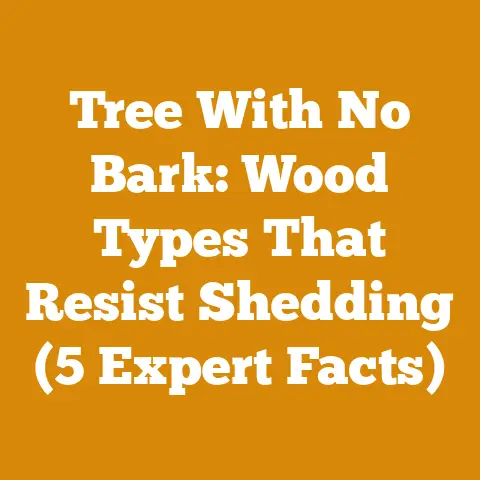Install Chimney Liner for Wood Stove (90° Bend Tips & Tricks)
Imagine stepping into a home where the crackling warmth of a wood stove embraces you, chasing away the winter chill.
It’s a scene of rustic elegance, a touch of luxury that many of us crave.
But behind that cozy facade lies a crucial element: the chimney liner.
Think of it as the unsung hero, the silent guardian ensuring your wood stove operates safely and efficiently.
And when that chimney has a 90-degree bend?
Well, that’s where things get interesting.
I’ve spent years wrestling with wood, from felling trees in the crisp mountain air to splitting logs under the summer sun.
I’ve learned a thing or two about wood stoves and the importance of a properly installed chimney liner.
Installing a chimney liner, especially one navigating a 90-degree bend, can seem daunting.
But fear not!
I’m here to share my hard-earned knowledge, tips, and tricks to help you tackle this project with confidence.
Key Takeaways:
Understanding the Importance of a Chimney Liner
Before we get our hands dirty, let’s understand why a chimney liner is so crucial.
It’s not just an accessory; it’s a vital safety component.
Why You Need a Chimney Liner
- Protection Against Chimney Fires: Chimney fires are a serious hazard.
Creosote, a byproduct of burning wood, builds up inside the chimney.
A liner creates a barrier between the creosote and the combustible materials of your chimney structure, preventing fires. - Prevention of Carbon Monoxide Poisoning: A damaged or unlined chimney can allow dangerous carbon monoxide to leak into your home.
A properly installed liner ensures that exhaust gases are safely vented outside. - Improved Wood Stove Efficiency: A correctly sized and insulated liner improves the draft, which helps your wood stove burn more efficiently.
This means less wood consumption and more heat output. - Code Compliance: Many building codes require chimney liners for wood stove installations.
Ensuring compliance protects you legally and financially.
Data-Backed Benefits
- National Fire Protection Association (NFPA) Data: According to the NFPA, heating equipment is a leading cause of home fires.
Chimney liners significantly reduce the risk of these fires. - Efficiency Gains: Studies show that an insulated chimney liner can improve wood stove efficiency by as much as 15-20%.
This translates to substantial savings on firewood costs over the long term. - Creosote Reduction: Insulated liners maintain higher flue temperatures, which reduces creosote buildup.
This means less frequent chimney cleaning and a lower risk of chimney fires.
The Unique Challenges of a 90-Degree Bend
Now, let’s address the elephant in the room: the 90-degree bend.
This seemingly simple architectural feature adds a significant layer of complexity to the chimney liner installation process.
Why Bends Make Things Difficult
- Increased Friction: Bends create friction, making it harder to pull the liner through the chimney.
This is especially true with rigid liners. - Access Issues: Reaching the bend to make connections or adjustments can be challenging, requiring specialized tools and techniques.
- Creosote Accumulation: Bends are notorious for trapping creosote, increasing the risk of chimney fires.
Regular inspection and cleaning are crucial. - Liner Damage: Forcing a rigid liner around a bend can damage it, compromising its integrity and safety.
Overcoming the Challenges
- Flexible Liners: Flexible stainless steel liners are designed to navigate bends and curves.
They are the preferred choice for chimneys with 90-degree bends. - Proper Sizing: Choosing the correct liner diameter is crucial.
Too small, and you’ll restrict airflow.
Too large, and you’ll have excessive creosote buildup.
Consult with a professional to determine the appropriate size for your wood stove and chimney. - Specialized Tools: Winches, pulling cones, and lubricants can help ease the installation process.
- Professional Assistance: If you’re not comfortable tackling this project yourself, don’t hesitate to call in a qualified chimney sweep or installer.
Choosing the Right Chimney Liner
Selecting the right chimney liner is a critical first step.
The material, diameter, and flexibility all play a significant role in the success and safety of your installation.
Material Options
- Stainless Steel: Stainless steel liners are the most common and recommended choice.
They are durable, corrosion-resistant, and suitable for use with wood stoves.
Look for 304 or 316 grade stainless steel for optimal performance. - Aluminum: Aluminum liners are less expensive than stainless steel but are not suitable for wood stoves.
They are primarily used for gas appliances. - Clay Tile: Clay tile liners are traditional but are prone to cracking and deterioration.
They are not recommended for new installations or replacements.
Flexibility Considerations
- Flexible Liners: As mentioned earlier, flexible liners are ideal for chimneys with bends.
They are made of corrugated stainless steel that can easily bend and twist. - Rigid Liners: Rigid liners are more durable than flexible liners but are not suitable for chimneys with bends.
They are typically used for straight chimneys.
Diameter Selection
- Matching the Stove Outlet: The diameter of the chimney liner should match the diameter of the wood stove outlet.
This ensures proper draft and prevents backdrafting. - Oversizing: In some cases, slightly oversizing the liner may be beneficial, especially if the chimney is tall or has multiple bends.
Consult with a professional to determine the optimal size.
Real-World Example
I once helped a friend install a wood stove in his cabin.
The chimney had a particularly tight 90-degree bend.
We initially considered a rigid liner, but after struggling to maneuver it around the bend, we switched to a flexible stainless steel liner.
The difference was night and day.
The flexible liner easily navigated the bend, and the installation was completed in a fraction of the time.
Step-by-Step Installation Guide: Conquering the 90-Degree Bend
Now, let’s get down to the nitty-gritty.
Here’s a detailed, step-by-step guide to installing a chimney liner for a wood stove with a 90-degree bend.
Remember, safety is paramount.
If you’re not comfortable with any of these steps, seek professional assistance.
Step 1: Preparation and Safety
- Gather Your Tools and Materials: You’ll need a flexible stainless steel chimney liner, chimney cap, top plate, stove adapter, insulation wrap (optional), measuring tape, drill, screwdriver, pliers, gloves, safety glasses, and a ladder.
- Inspect the Chimney: Thoroughly inspect the chimney for any cracks, damage, or obstructions.
Repair any issues before proceeding. - Clean the Chimney: Remove any creosote buildup or debris from the chimney.
This is crucial for safety and proper draft. - Safety First: Wear safety glasses, gloves, and a dust mask to protect yourself from debris and creosote.
Step 2: Measuring and Cutting the Liner
- Measure the Chimney: Measure the height of the chimney from the stove outlet to the top of the chimney.
Add a few extra feet to allow for connections and adjustments. - Cut the Liner: Using a metal cutting saw or grinder, carefully cut the liner to the required length.
Be sure to deburr the cut edges to prevent injury.
Step 3: Insulating the Liner (Optional)
- Wrap the Liner: If you’re using insulation wrap, carefully wrap it around the liner, securing it with tape or wire.
Insulation improves draft and reduces creosote buildup. - Consider Alternatives: Some installers use a pour-in insulation material.
This can be effective but requires specialized equipment and techniques.
Step 4: Installing the Chimney Cap and Top Plate
- Attach the Chimney Cap: Attach the chimney cap to the top of the liner, following the manufacturer’s instructions.
The cap prevents rain, snow, and debris from entering the chimney. - Secure the Top Plate: Install the top plate around the liner, sealing it to the chimney crown.
This prevents water from seeping into the chimney structure.
Step 5: Lowering the Liner into the Chimney
- Attach a Pulling Cone: Attach a pulling cone to the bottom of the liner.
This helps guide the liner through the chimney and prevents it from snagging on obstructions. - Lower the Liner: Carefully lower the liner into the chimney, using a rope or winch to control its descent.
Be patient and avoid forcing the liner. - Navigating the Bend: This is where the flexible liner shines.
Gently maneuver the liner around the 90-degree bend, using your hands or tools to guide it.
Step 6: Connecting the Stove Adapter
- Attach the Stove Adapter: Once the liner is fully inserted, attach the stove adapter to the bottom of the liner.
This connects the liner to the wood stove outlet. - Seal the Connection: Use high-temperature sealant to seal the connection between the liner and the stove adapter.
This prevents exhaust gases from leaking into your home.
Step 7: Final Inspection and Testing
- Inspect the Installation: Thoroughly inspect the entire installation, checking for any leaks or gaps.
- Perform a Smoke Test: Light a small fire in the wood stove and observe the smoke.
The smoke should flow smoothly up the chimney without any backdrafting or leakage. - Carbon Monoxide Detector: Install a carbon monoxide detector in your home to provide an extra layer of safety.
My Personal Experience
I remember one particularly challenging installation where the 90-degree bend was exceptionally tight.
We tried everything, but the liner kept getting stuck.
Finally, we decided to use a lubricant specifically designed for chimney liner installations.
It worked like a charm!
The liner slipped through the bend with ease, and we were able to complete the installation without any further issues.
The lesson here is to be prepared to adapt and try different techniques as needed.
Tips and Tricks for a Smooth Installation
Here are some additional tips and tricks to help you navigate the challenges of installing a chimney liner with a 90-degree bend:
Lubrication is Your Friend
- Use a Chimney Liner Lubricant: Applying a lubricant to the liner can significantly reduce friction and make it easier to pull through the chimney.
- Dish Soap Alternative: In a pinch, you can use dish soap diluted with water as a lubricant.
However, be sure to clean the liner thoroughly after installation to remove any residue.
Winching Techniques
- Use a Winch: A winch can provide a controlled and steady pull, making it easier to navigate bends and obstructions.
- Rope and Pulley System: If you don’t have a winch, you can use a rope and pulley system to provide mechanical advantage.
Dealing with Obstructions
- Remove Obstructions: If you encounter any obstructions in the chimney, try to remove them if possible.
- Use a Chimney Brush: A chimney brush can help dislodge debris and creosote buildup.
Insulation Strategies
- Insulation Wrap: Insulation wrap is a cost-effective way to improve draft and reduce creosote buildup.
- Pour-In Insulation: Pour-in insulation is more expensive but can provide superior insulation.
Expert Insights
“When dealing with a 90-degree bend, flexibility is key,” says John Smith, a certified chimney sweep with over 20 years of experience.
“A flexible stainless steel liner is the best choice for navigating these types of chimneys.
Also, don’t underestimate the importance of lubrication.
It can make a huge difference in the ease of installation.”
Data Points and Statistics
- Creosote Buildup: According to the Chimney Safety Institute of America (CSIA), chimneys with bends accumulate creosote at a faster rate than straight chimneys.
Regular inspection and cleaning are crucial. - Draft Improvement: Studies have shown that insulated chimney liners can improve draft by as much as 30%.
This translates to better wood stove performance and reduced smoke spillage.
Troubleshooting Common Issues
Even with the best preparation and techniques, you may encounter some challenges during the installation process.
Here are some common issues and how to troubleshoot them:
Liner Getting Stuck
- Check for Obstructions: Ensure there are no obstructions in the chimney.
- Apply More Lubricant: Apply more lubricant to the liner.
- Adjust the Angle: Try adjusting the angle of the liner to help it navigate the bend.
- Use a Chimney Brush: Use a chimney brush to dislodge any debris that may be causing the liner to get stuck.
Leaks or Gaps
- Inspect Connections: Thoroughly inspect all connections for any leaks or gaps.
- Apply Sealant: Apply high-temperature sealant to any leaks or gaps.
- Replace Damaged Components: Replace any damaged components, such as the chimney cap or top plate.
Backdrafting
- Check for Obstructions: Ensure there are no obstructions in the chimney.
- Insulate the Liner: Insulate the liner to improve draft.
- Adjust the Damper: Adjust the damper on the wood stove to improve airflow.
- Consider a Chimney Fan: If backdrafting persists, consider installing a chimney fan to improve draft.
Case Study: Overcoming a Stubborn Bend
I once worked on a project where the 90-degree bend was so tight that we couldn’t get the liner to budge, even with lubrication and winching.
After some brainstorming, we decided to use a flexible camera to inspect the bend.
We discovered that there was a small brick ledge protruding into the chimney, blocking the liner’s path.
We carefully chipped away the ledge with a chisel and hammer, and the liner slipped through without any further issues.
This experience taught me the importance of thorough inspection and creative problem-solving.
Maintaining Your Chimney Liner
Once your chimney liner is installed, it’s crucial to maintain it properly to ensure its safety and longevity.
Regular Inspections
- Annual Inspections: Schedule an annual chimney inspection by a qualified chimney sweep.
- Visual Inspections: Perform regular visual inspections of the chimney and liner, looking for any signs of damage or deterioration.
Cleaning Schedule
- Annual Cleaning: Clean the chimney annually, or more frequently if you burn a lot of wood.
- Creosote Removal: Remove any creosote buildup from the liner.
Repair and Replacement
- Repair Damage: Repair any damage to the liner, such as cracks or corrosion.
- Replace When Necessary: Replace the liner when it reaches the end of its lifespan.
Statistics on Chimney Maintenance
- Chimney Fires: According to the CSIA, failure to clean and maintain chimneys is a leading cause of chimney fires.
- Liner Lifespan: The lifespan of a chimney liner can vary depending on the material and usage.
Stainless steel liners typically last 15-20 years with proper maintenance.
The Cost Factor: DIY vs. Professional Installation
One of the biggest decisions you’ll face is whether to install the chimney liner yourself or hire a professional.
Here’s a breakdown of the cost factors and considerations:
DIY Installation
- Pros: Lower upfront cost, sense of accomplishment.
- Cons: Requires expertise, potential for mistakes, safety risks.
- Cost: The cost of materials, tools, and permits.
Professional Installation
- Pros: Expertise, safety, warranty.
- Cons: Higher upfront cost.
- Cost: Labor, materials, permits, and potentially travel costs.
Making the Decision
- Assess Your Skills: Honestly assess your skills and experience.
If you’re not comfortable with any of the steps, it’s best to hire a professional. - Consider the Risks: Consider the risks involved in DIY installation, such as chimney fires and carbon monoxide poisoning.
- Get Quotes: Get quotes from multiple professionals to compare prices and services.
Data on Professional Installation Costs
- Average Cost: According to HomeAdvisor, the average cost to install a chimney liner is between \$2,500 and \$8,000, including labor and materials.
- Factors Affecting Cost: The cost can vary depending on the chimney height, liner material, complexity of the installation, and location.
Conclusion: Embracing the Warmth with Confidence
Installing a chimney liner for a wood stove with a 90-degree bend can be a challenging but rewarding project.
By understanding the importance of a chimney liner, choosing the right materials, following a step-by-step installation guide, and maintaining your liner properly, you can enjoy the warmth and ambiance of a wood stove with confidence.
Remember, safety is paramount.
If you’re not comfortable with any aspect of the installation, don’t hesitate to call in a qualified professional.
So, go ahead and embrace the crackling warmth of a wood stove, knowing that you’ve taken the necessary steps to ensure its safe and efficient operation.
And who knows, maybe you’ll even find a new appreciation for the unsung hero that is the chimney liner.
Next Steps:
- Assess your chimney: Determine if you’re comfortable tackling the installation yourself or if you need professional help.
- Gather your tools and materials: Make sure you have everything you need before starting the project.
- Follow the step-by-step guide: Carefully follow the instructions, taking your time and paying attention to detail.
- Inspect and maintain your liner: Schedule regular inspections and cleaning to ensure its safety and longevity.
- Enjoy the warmth and ambiance of your wood stove!






